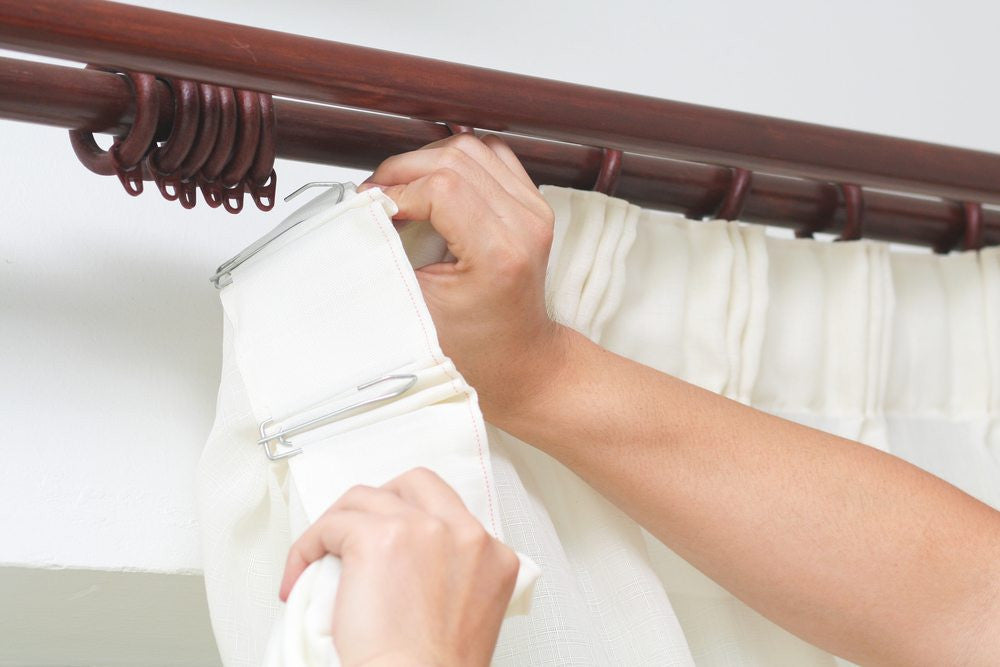How do I clean my curtain pole to maintain it and keep it in good condition?
So you’ve gone to all the effort of choosing and installing your perfect curtain pole, the curtains are installed, the tools are tidied away (or the curtain fitters have gone) and there’s not a speck of dust to be seen near your fabulous new window treatment. But how long will it be before the newness is gone, your sparkling finials have dulled, the finish on your curtain pole has tarnished and it’s an incredible effort to drag the curtains along what was once a smooth, swishy and easy to operate curtain pole? Thankfully curtain poles for eyelet curtains as well as other pole types too are very low maintenance when it comes to cleaning, but to ensure that you get the best looks and maximum performance out of your curtain poles we’ve put together some quick and easy top tips for cleaning your curtain pole:
- General use and maintenance tips
- Opening your curtains
- Hand drawn curtain poles
- Corded curtain poles
- Spares and repairs
- Children and pets
- How to clean wooden curtain poles
- How to clean bay window poles
General use and maintenance tips for keeping your curtain pole in tip-top condition
Many people view a curtain pole as a household appliance that once installed, will give them years of trouble free service; and on the whole that is right. However, by using and operating your curtain pole properly you will extend the years of trouble free service it will give you.Opening your curtains
Opening and closing your curtains properly for example, is one of the best ways of reducing wear and tear on your curtain pole. You may think that this is simple, but the way in which you open and close your curtains can affect the condition and longevity of your curtain poles considerably.Hand drawn curtain poles
If you have a non-corded curtain pole, which means that you will be opening and closing your curtains by hand, then when you open your curtains, reach up and gently grab the leading edge as close to the top of the curtain as possible and dealing with one curtain at a time, slide the curtain across to the centre of the pole with a slow and smooth but consistent movement, lifting the curtain slightly to take up a little of the weight as you do so. Avoid pulling down on your curtains or snatching them across the pole in a sharp or jerky manner as this will put strain on the curtain pole, the brackets and your curtains.

If you feel any resistance or experience difficulty in drawing the curtains across the pole at any time, then stop and investigate the problem straight away. Do not force the curtain or tug hard to move them as you may cause irreparable damage to either the curtain or the pole. It could be a simple problem such as a curtain ring jamming or a bit of lubrication being needed and it is better to fix a simple problem as soon as you experience it than to ignore it. Similarly, when opening your curtains again, exercise the same patience and caution and don’t be tempted to push them apart quickly from the centre outwards.
Deal with one curtain at a time and taking some of the curtain weight off the pole by lifting the curtains slightly, push the curtains back in a slow, smooth manner into the open position. Don’t force the curtains too far back off the window as you may find that this pushes the curtain pole rings too close together and can cause them to jam or interlock with each other, particularly on metal poles. If you have fitted your curtain rods or pole correctly with the right amount of overhang to either side of the window then you should have plenty of stack-back space for the curtains to push back into without scrunching the curtain pole rings up too close together.
Corded curtain poles
If your curtain pole is a corded one, then the operating system will have been designed to close and open both curtains together at the same time. Pull the operating cords firmly but slowly to achieve a smooth consistent draw. Pulling hard or fast or jerking on the cords of corded curtain poles is a guaranteed way of wearing the cords quickly and putting unnecessary strain on the pulley system, overlap arms and the pole brackets.
If the cords jam on you stop and investigate the problem straight away and never try pulling extra hard to force the cords. Frequent dusting and cleaning is essential with corded curtain poles to keep them in good working order and occasional lubrication may be beneficial. However, over lubricating corded poles can create slip in the cords and actually be detrimental rather than beneficial to corded curtain poles.
Spares and repairs
If treated and maintained properly you are unlikely to need carry out any repairs or replace broken parts on your curtain pole. However, accidents do happen and should any damage occur then act on it straight away. If for example, you notice that a fixing is coming out of the wall and as a result a bracket is looking a tad wobbly or loose, then get it re-drilled and secured quickly, as ignoring the problem with either result in the bracket coming out of the wall completely with continued use and the curtain pole eventually falling down, or damage to the bracket itself or even the curtains.

If any parts of your pole should break for any reason, such as rings or brackets for example, then replace them straight away. We stock spares for the vast majority of our curtain poles at Terry’s, making the care and maintenance of curtain poles purchased from us simple and easy.
Children and pets
This may seem like a strange consideration to take into account with regard to maintaining your curtain poles, but as silly as it sounds safeguarding your new curtain poles against mischievous kittens with sharp scratchy claws, hungry hamsters that like to nibble through wood or fabric, cheeky birds who prefer your curtain pole to their perch and imaginative children who see your curtain poles and curtains as a stage for their play, ships sails, a climbing frame, or exercise pull-up bar - is not as crazy as it sounds!
Your curtain poles will serve you well and stay trouble free and in full working order if they are used in the proper manner and for the purpose for which they were intended. So avoid any of the above mentioned activities where you can and be especially mindful of young children around corded curtain poles because of the risk of strangulation.
How to clean wooden curtain poles
Wooden curtain poles can be cleaned in very much the same way as metal curtain poles, in as much as they need to be cleaned on a regular basis. Again dusting or wiping them as often as you would do your coffee tables, window sills, ornaments and mirrors is recommended. Cleaning them with a soft dry cloth or feather duster is recommended weekly. Cleaning with a damp cloth however, may not always be appropriate depending on the finish on the curtain pole. If the pole is stained or has a paint or specialist crackle finish then the chances are it has been lacquered or sealed with a top coat to protect the finish; and in these instances using a soft damp cloth and thoroughly drying afterwards with a soft dry cloth is recommended once a month.

If you have a natural unfinished wooden pole however, and you want to keep the completely natural look then using a damp cloth is not recommended as any damp can be absorbed by the untreated wood and overtime could affect the colour. It is best to avoid any kind of lubricant or cleaning product on unfinished wooden poles in fact and instead to keep them clean and dust free with regular dusting. Using a soft upholstery brush attachment on your vacuum cleaner can be a good way of giving them a deep down dusting every month or so instead. As with our advice on metal curtain poles, if you find your wooden curtain pole is starting to get a little difficult to use and not as smooth to operate as it was when it was new, despite regular cleaning, then it may need a little lubrication to improve the operation.
You don’t need any special chemicals, a home cleaning product such as furniture polish will do the trick, but make sure it’s a multi-purpose, multi-surface, cleaner rather than a wax based furniture product; and check on the label that it can be used on wooden surfaces before you use it on your wooden curtain pole. It is often worth doing a small patch test on the back of the pole (especially on special effect or crackle finishes) near the end where the curtains sit, where it will be inconspicuous should it have any effect on the finish of the pole. Again as with metal curtain poles, it is best to avoid wax polishes.
This may sound strange as wax furniture polishes are usually designed to be used on wood, but wooden curtain poles have moving, working parts which need minimal friction to be able to work effectively. Wax will stay on a wooden curtain pole creating reduced friction for the working parts (i.e. the pole rings), but far from improving the performance of the pole, this could actually make it worse over time as it encourages dust and dirt to stick to the curtain pole, creating a sticky build up, which eventually increases the friction and hampers performance. In fact, avoid using any kind of grease based lubricants as these will attract muck and dirt in the same way that wax will and you could risk the grease transferring to your curtains.

Silica based sprays are better than grease or wax based products if you don’t want to use furniture polishes on your wooden curtain pole, but silica is still a non-drying substance that will sit on your pole. However, silica sprays won’t hang around as long as wax or grease based products so can be a good choice for lubricating wooden curtain poles so long as you keep on top of the regular cleaning so that there is no dust or dirt build up. At Terry’s, our fitters often use silica sprays or PTFE sprays, particularly on old or difficult curtain poles and tracks once they have been cleaned, as these dry more like a light powder coating with a very slippery surface.
These are nowhere near as long lasting as grease, wax or silica and need to be re-applied more frequently but are very effective combined with a regular cleaning routine. N.B. It is very important when using any chemical lubricants that you do not spray or apply them on or near your curtain fabric as this could cause staining or colour change. Always release the last ring or end stop and slide your curtains to one end of the curtain pole before you start applying lubricant and deal with one half of the curtain pole at a time.
How to clean bay window poles
If you have already installed bay window curtain poles in your home, you will more than likely agree that they are probably far and above the most complex of all types of curtain poles to choose and install? Moreover if you’ve fitted one yourself, then no doubt you won’t want to be taking it down again anytime soon; and if you’ve employed the services of a professional track fitter, then you will also no doubt have invested in the cost of a few hours of his professional services and won’t want to be calling him back any time soon either? Therefore, treating and using your bay pole properly and maintaining it well is doubly important.

Whichever the case, both scenarios will give you good reason to want to maintain your bay window pole and keep it in good working order for as long as possible. For cleaning and maintenance advice follow the advice given above in our guides on how to clean metal or wooden curtain poles, depending on which type of bay pole you have. It is doubly important with bay window poles not to put any unnecessary weight or stress on the pole when drawing the curtains for a number of reasons. Very often bay poles are top fixed into the ceiling of a bay window rather than being face fixed to the wall.
The ceilings of bay windows are often hollow and can be notoriously difficult to get a good fixing into. If you have fitted your bay window pole correctly and with appropriate hollow cavity fixings, then it may certainly be secure enough to support and operate your curtains properly on a daily basis, but will be susceptible to coming down if undue weight or pressure is applied to the pole. As with straight curtain poles then, it is important to draw your curtains with a smooth, slow action and not to pull down on the curtains as you do so or to pull them too quickly.
Bay window poles that use the split ring system with passing brackets have ‘c’ shaped curtain rings rather than full circular ‘o’ rings and are designed so that the gap in the curtain rings can pass over the pole brackets, making it possible to have full working curtains to draw all the way around the bay window. If the curtains are pulled on too hard or drawn too fast, this can cause the ‘c’ rings to come off the pole, so drawing the curtains slowly and smoothly reduces the risk of this happening. Not lifting the curtains up to reduce the weight as you draw them is also beneficial as lifting the curtain can sometimes dislodge the ‘c’ rings too. If you do notice any rings that have come off, clip them back on straight away as a loose ring can cause the rings to either side of it to come off too. Avoid letting pets such as dogs and cats sit on the window sills or behind the curtains of bay windows that have bay poles with ‘c’ rings as this could cause the rings to become detached more frequently than normal.

























































